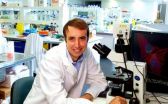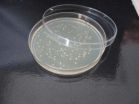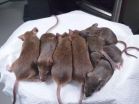(Press-News.org) VIDEO:
What happens when human brain cells that surround and support neurons are implanted into the brains of newborn mice? Researchers reporting in the March 7th issue of the Cell Press...
Click here for more information.
What happens when human brain cells that surround and support neurons are implanted into the brains of newborn mice? Researchers reporting in the March 7th issue of the Cell Press journal Cell Stem Cell recently found that such mice had enhanced learning and memory when compared with normal mice that hadn't received the transplanted human cells. The findings indicate that these supportive cells, called glia, play an important role in human cognition.
As the human brain evolved, glia became much larger and more varied than those in the brains of rodents. Glia do not conduct electrical impulses like neurons do, but they can modulate neural activity, leading researchers to wonder how these evolutionary changes have benefited humans.
"To assess the species-specific contribution of glia to neural processing and plasticity and the specific advantages, if any, of human glia in cognition, we grafted human glial progenitor cells into the brains of newborn mice and then waited for the mice to grow to adulthood," explains Dr. Steve Goldman, who together with his collaborator Dr. Maiken Nedergaard directs the Center for Translational Neuromedicine at the University of Rochester Medical Center. "We then assessed both neurophysiological and behavioral measures of learning and memory, finding that the engrafted mice exhibited more rapid learning of both conditioned associations and goal-directed tasks." The neuronal connections within their brains also demonstrated characteristics of enhanced learning.
These findings indicate that human glia differ functionally from those of rodents and that they contribute significantly to learning. "As such, our findings suggest that the evolution of human cognition may reflect the development of human-specific glial form and function," says Dr. Goldman.
In a parallel study published in the journal in early February, Dr. Goldman and his team reported that they could efficiently generate glial progenitor cells from human skin cells reprogrammed into induced pluripotent cells. As a result, the researchers can now establish glial progenitor cells on a patient-specific basis from individuals with brain diseases, including a number of neuropsychiatric and neurological disorders that are relatively specific to humans. By implanting these cells into mice as they did in this most recent study, the investigators can assess the role of glial cells in these disorders, as well as test different treatment strategies that target abnormal glial function. They are currently carrying out these experiments with cells from patients with schizophrenia and Huntington's disease.
###
Cell Stem Cell, Han et al.: "Forebrain engraftment by human glial progenitor cells enhances synaptic plasticity and learning in adult mice."
Using human brain cells to make mice smarter
2013-03-07
ELSE PRESS RELEASES FROM THIS DATE:
Persistence pays off in solving hemophilia mystery, showing curiosity drives discovery
2013-03-07
An Australian researcher has found the third and final missing piece in the genetic puzzle of an unusual form of hemophilia, more than 20 year after he discovered the first two pieces.
Professor Merlin Crossley, of the University of New South Wales, and his international team studied the blood-clotting disorder, hemophilia B Leyden, which is unusual because symptoms improve after puberty.
The results, published in The American Journal of Human Genetics, explain how more than half of the cases of this rare, hereditary bleeding disorder occur, and could help improve understanding ...
American Academy of Microbiology releases resistance report
2013-03-07
What do cancer cells, weeds, and pathogens have in common? They all evolve resistance to the treatments that are supposed to eliminate them. However, researchers developing the next generation of antibiotics, herbicides, and anti-cancer therapeutics rarely come together to explore the common evolutionary principles at work across their different biological systems. The new American Academy of Microbiology report "Moving Targets: Fighting Resistance in Infections, Pests, and Cancer" concludes that scientists working on different kinds of treatments have much to learn from ...
Dual systems key to keeping chromosomes intact
2013-03-07
USC scientists have discovered how two different structural apparatuses collaborate to protect repetitive DNA when it is at its most vulnerable – while it is being unzipped for replication.
The centromere—the center of the "X" shape of a chromosome—contains repeated DNA sequences that are epigenetically coded to attract so-called heterochromatin proteins. This protects the structure to ensure that the chromosomes separate properly. If the heterochromatin is lost (due to mutations in the cell), the repetitive DNA becomes vulnerable to rearrangements and recombination. ...
New hypothesis: Why bacteria are becoming increasingly more resistant to antibiotics
2013-03-07
According to his theory, bacteria that are non-resistant to antibiotics acquire said resistance accidentally because they take up the DNA of others that are resistant, due to the stress to which they are subjected.
A University of Granada researcher has formulated a new hypothesis concerning an enigma that the scientific community has still not been able to solve and which could revolutionise the pharmaceutical industry: Why are bacteria becoming increasingly more resistant to antibiotics? His work has revealed that the use of antibiotics can even cause non-resistant bacteria ...
New gender benchmarking study: India is making slow progress in advancing women in S & T
2013-03-07
Delhi, March 7, 2013 - In the first gender benchmarking study of its kind, researchers have found that numbers of women in the science, technology and innovation fields are alarmingly low in the world's leading economies, and are actually on the decline in many, including the United States. India's low overall ranking in the study shows slow progress despite women friendly policies which have been in place for a number of years.
The full gender benchmarking study maps the opportunities and obstacles faced by women in science in Brazil, South Africa, India, the Republic ...
New gender benchmarking study: South Africa ranks low on women participating in STI
2013-03-07
Cape Town, March 7, 2013 – In the first gender benchmarking study of its kind, researchers have found that numbers of women in the science, technology and innovation fields (STI) are alarmingly low in the world's leading economies, and are actually on the decline in many, including the United States. For South Africa, results show that women have more opportunities available to them than ever before, however, their participation in the science, technology and innovation workforce remains low.
The full gender benchmarking study maps the opportunities and obstacles faced ...
Japanese researchers succeed in making generations of mouse clones
2013-03-07
Using the technique that created Dolly the sheep, researchers from the RIKEN Center for Developmental Biology in Kobe, Japan have identified a way to produce healthy mouse clones that live a normal lifespan and can be sequentially cloned indefinitely.
Their study is published today in the journal Cell Stem Cell.
In an experiment that started in 2005, the team led by Dr. Teruhiko Wakayama has used a technique called somatic cell nuclear transfer (SNCT) to produce 581 clones of one original 'donor' mouse, through 25 consecutive rounds of cloning.
SNCT is a widely ...
High BMI linked to heart attack, stroke in young women
2013-03-07
SAN FRANCISCO (March 7, 2013) —A nationwide study of women in Denmark who are of child-bearing age finds that those who are obese appear to have a much greater risk of heart attack or stroke, according to research being presented at the American College of Cardiology's 62nd Annual Scientific Session.
In fact, women with a high body mass index (BMI)—a measure of the body's fat content—that is indicative of obesity were twice as likely as those of normal weight to suffer a potentially life-threatening heart attack or stroke within just four to five years following childbirth. ...
Duckweed as a cost-competitive raw material for biofuel production
2013-03-07
The search for a less-expensive, sustainable source of biomass, or plant material, for producing gasoline, diesel and jet fuel has led scientists to duckweed, that fast-growing floating plant that turns ponds and lakes green. That's the topic of a report in ACS' journal Industrial & Engineering Chemistry Research.
Christodoulos A. Floudas, Xin Xiao and colleagues explain that duckweed, an aquatic plant that floats on or near the surface of still or slow-moving freshwater, is ideal as a raw material for biofuel production. It grows fast, thrives in wastewater that has ...
First discovery of a natural topological insulator
2013-03-07
In a step toward understanding and exploiting an exotic form of matter that has been sparking excitement for potential applications in a new genre of supercomputers, scientists are reporting the first identification of a naturally occurring "topological insulator" (TI). Their report on discovery of the material, retrieved from an abandoned gold mine in the Czech Republic, appears in the ACS journal Nano Letters.
Pascal Gehring and colleagues point out that synthetic TIs, discovered only a decade ago, are regarded as a new horizon in materials science. Unlike conventional ...


